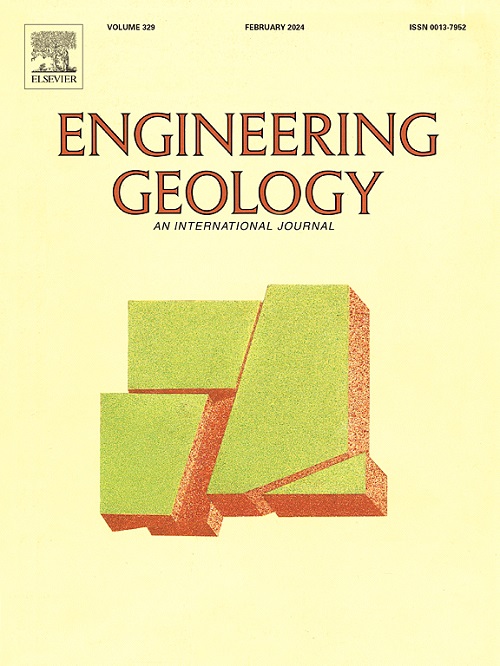Shear strength characteristics of unsaturated compacted GMZ bentonite considering anisotropy
IF 6.9
1区 工程技术
Q1 ENGINEERING, GEOLOGICAL
引用次数: 0
Abstract
Anisotropic microstructure would be generated in the bentonite block during unidirectional compactions. Working as buffer materials, the compacted bentonite will inevitably experience shearing processes during the long-term operation of geological repositories. In this paper, high-pressure triaxial tests were conducted on unsaturated compacted GMZ bentonite specimens with different water contents, dry densities and confining stresses, with the compaction surface of the specimens oriented in both horizontally (H-type) and vertically (V-type) configurations. Results demonstrate that an increase in water content leads to a reduction in both peak strength and residual strength, while higher confining stresses enhance these strength parameters. Normally consolidated and lightly over-consolidated bentonite specimens display substantial shear deformation, whereas heavily over-consolidated specimens tend to experience brittle failure. Water content plays a significant role in shaping both the critical state line (CSL) and the Hvorslev surface (HS), with increasing water content resulting in decreased slope parameters for both and an increased intercept parameter for the HS. Generally, V-type specimens demonstrate a steeper CSL and an outwardly extended HS in contrast to that of H-type specimens. The critical state ratio for V-type specimens is about 10 % higher, and the friction angle is 2.8° greater, than that of the H-type ones. Moreover, this difference appears to increase with increasing water content. The difference of the HS slope parameter between the two specimens is minor, while the intercept parameter is higher for the V-type specimens.
考虑各向异性的非饱和压实GMZ膨润土的剪切强度特性
在单向压实过程中,膨润土块会产生各向异性的微观结构。作为缓冲材料,压实膨润土在地质处置库的长期运行过程中不可避免地会经历剪切过程。本文对具有不同含水量、干密度和约束应力的非饱和压实 GMZ 膨润土试样进行了高压三轴试验,试样的压实面有水平(H 型)和垂直(V 型)两种方向。结果表明,含水量增加会导致峰值强度和残余强度降低,而较高的约束应力则会提高这些强度参数。正常固结和轻度过固结膨润土试样显示出巨大的剪切变形,而重度过固结试样则倾向于发生脆性破坏。含水量对临界状态线(CSL)和赫沃斯列夫表面(HS)的形成起着重要作用,含水量的增加会导致两者的斜率参数降低,HS 的截距参数增加。一般来说,与 H 型试样相比,V 型试样的临界状态线更陡,HS 向外延伸。与 H 型试样相比,V 型试样的临界状态比高约 10%,摩擦角大 2.8°。此外,随着含水量的增加,这种差异似乎也在增大。两种试样的 HS 坡度参数差别不大,而 V 型试样的截距参数较高。
本文章由计算机程序翻译,如有差异,请以英文原文为准。
求助全文
约1分钟内获得全文
求助全文
来源期刊

Engineering Geology
地学-地球科学综合
CiteScore
13.70
自引率
12.20%
发文量
327
审稿时长
5.6 months
期刊介绍:
Engineering Geology, an international interdisciplinary journal, serves as a bridge between earth sciences and engineering, focusing on geological and geotechnical engineering. It welcomes studies with relevance to engineering, environmental concerns, and safety, catering to engineering geologists with backgrounds in geology or civil/mining engineering. Topics include applied geomorphology, structural geology, geophysics, geochemistry, environmental geology, hydrogeology, land use planning, natural hazards, remote sensing, soil and rock mechanics, and applied geotechnical engineering. The journal provides a platform for research at the intersection of geology and engineering disciplines.
 求助内容:
求助内容: 应助结果提醒方式:
应助结果提醒方式:


